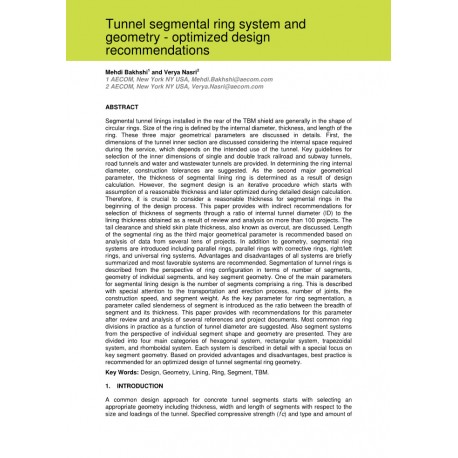Cart
0
0
No document
0,00 €
Total
Document successfully added to your shopping cart
Quantity
Total
There are 0 items in your cart.
There is 1 item in your cart.
Total documents
Total shipping
To be determined
Total
Search & filter
Search for a publication
Search & filter
Tunnel segmental ring system and geometry - optimized design recommendations
1910_tunnel_segmental_ring_syste
Segmental tunnel linings installed in the rear of the TBM shield are generally in the shape of circular rings. Size of the ring is defined by the internal diameter, thickness, and length of the ring. These three major geometrical parameters are discussed in details. First, the dimensions of the tunnel inner section are discussed considering the internal space required during the service, which depends on the intended use of the tunnel. Key guidelines for selection of the inner dimensions of single and double track railroad and subway tunnels, road tunnels and water and wastewater tunnels are provided. In determining the ring internal diameter, construction tolerances are suggested. As the second major geometrical parameter, the thickness of segmental lining ring is determined as a result of design calculation. However, the segment design is an iterative procedure which starts with assumption of a reasonable thickness and later optimized during detailed design calculation. Therefore, it is crucial to consider a reasonable thickness for segmental rings in the beginning of the design process. This paper provides with indirect recommendations for selection of thickness of segments through a ratio of internal tunnel diameter (ID) to the lining thickness obtained as a result of review and analysis on more than 100 projects. The tail clearance and shield skin plate thickness, also known as overcut, are discussed. Length of the segmental ring as the third major geometrical parameter is recommended based on analysis of data from several tens of projects. In addition to geometry, segmental ring systems are introduced including parallel rings, parallel rings with corrective rings, right/left rings, and universal ring systems. Advantages and disadvantages of all systems are briefly summarized and most favorable systems are recommended. Segmentation of tunnel rings is described from the perspective of ring configuration in terms of number of segments, geometry of individual segments, and key segment geometry. One of the main parameters for segmental lining design is the number of segments comprising a ring. This is described with special attention to the transportation and erection process, number of joints, the construction speed, and segment weight. As the key parameter for ring segmentation, a parameter called slenderness of segment is introduced as the ratio between the breadth of segment and its thickness. This paper provides with recommendations for this parameter after review and analysis of several references and project documents. Most common ring divisions in practice as a function of tunnel diameter are suggested. Also segment systems from the perspective of individual segment shape and geometry are presented.




